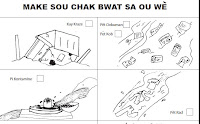In the days after the Sunday flood of the Ca Charles watershed, volunteers and part-time workers with the UN project went to all of the affected homes and assisted in clearing away mud, rocks, trees, and trash, helping the residents to gain some sense of order, and to cope with their losses.
Many of us joined the volunteers, and we were shocked by the extent of the damage to the homes and the crops. In a team meeting of the staff of Integrated Community Services (all of HAS’ activities outside the hospital), it was suggested that we would conduct a survey of homes which were in the flood cone, to determine the extent of the damage, and to identify priority families for assistance in rebuilding. We had hoped to immunize 3,000-4,000 people in the area of worst flooding against typhoid. Sadly the vaccines were not available in our area, so instead our health workers provided education about typhoid prevention.
We activated the animatrices, community volunteers who work with HAS as contacts with the community, reporting on births and deaths, finding cases of illness and referring them to the dispensary or hospital, and providing health education. Most of the women (and a few men) had previously participated in the survey of risk factors for malnutrition, so we used the same concept of a graphic survey, so that the mostly-illiterate women could mark the objects which they saw.
Today, most of the surveys have come into the office, and we are compiling them to cluster by sub-zones within the immediate hospital area. Over the weekend, we will compile the results and identify the highest-priority households to be visited and support with whatever resources we can find. We appreciate the responses which have come in after the first blogs in this series, and we have already seen that the needs are greater than we had imagined.
Ian and the Integrated Community Services team.
Saturday, July 24, 2010
Subscribe to:
Comments (Atom)







